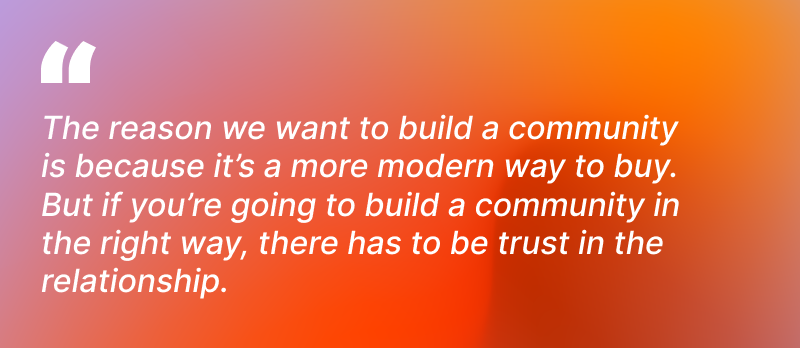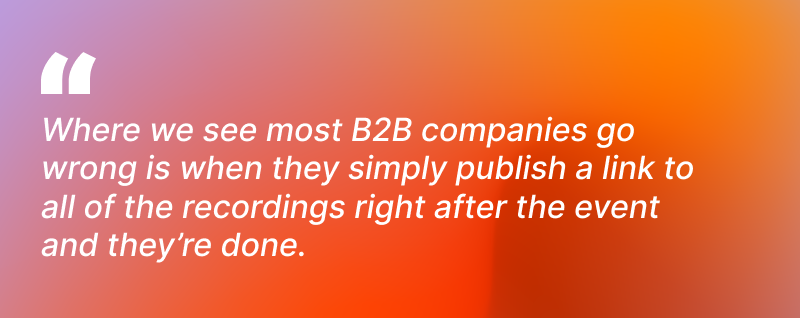Quality AND Quantity: How to Find and Engage More of The Right People For Your Event

Maximize Your Marketing ROI
Join 10,000 other marketers already getting the best tips on running engaging events that boost pipeline and create raving fans.
When you think of “event goals,” what are a few metrics that come to mind? Engagement? Pipeline? Revenue? What about… community? 👀
This is precisely the approach Metadata took with their annual DEMAND event. There were no lead or opportunity goals, just good vibes and a strong sense of community. But how did they pull this off? And how did they manage to get sales and leadership on board?
Metadata is the first demand generation platform for B2B marketers who need to get closer to revenue. Their platform helps marketers scale paid media experiments and testing with features like smart audience targeting, campaign automation, lead enrichment, and more.
Mark Huber, Head of Brand and Product Marketing, and Jason Widup, VP of Marketing, joined us for a live webinar where they shared:
- Why they launched an event with zero lead goals 🤯
- How they reduced their cost-per-lead by over 100% with experiments 💸
- Their philosophy on marketing attribution 📈
- How they repurposed content for 5 months after the live event 🌟
- … and much more!
Whether you’re new to events or you’re looking for smart ways to level up your approach, this webinar is for you!
Check out our recap below👇 and be sure to check out the full recording for event more event marketing insight!
Why did Metadata host DEMAND in 2021? Tell us more about your strategy.
To be honest, events weren’t initially on our radar. We did a live customer event in 2019. We had 30 people come for a day of speaking. We thought it went well, and it was a relatively low effort play.
We initially turned down the idea of doing more events, but we eventually came around. We really did not believe that events could have a direct impact on demand, and that was our biggest priority at the time. Spoiler alert: it does.
Why did we finally decide to go for it? Well, everyone has been talking about “community” for the past year. We wanted to dip our toes in building an audience and, ultimately, a community. We looked at this event as a huge first step.
“We really did not believe that events could have a direct impact on demand. Spoiler alert: it does.”
We wanted to build an event from the attendee perspective. We thought—”what type of event would we want to attend?” We had never held a virtual event before, but that actually worked to our advantage.
We also noticed that other B2B SaaS companies weren’t getting nearly as much as they should out of an event when it comes to content. We saw a huge opportunity to get 5+ months worth of content out of a single event.
Outside of building a community, what were some of the goals you set around DEMAND?
I’ll start by answering a different question first. What we didn’t want was there to be a notion of “leads”.
When you’re focusing on building a community and you approach an event with goals around leads, opportunity, and revenue—you’re coming at it from the wrong perspective.
The reason we want to build a community is because it’s a more modern way to buy. Communities can extend the word of mouth, social proof, etc. But if you’re going to build a community in the right way, there has to be trust in the relationship. So for us, the event was about building that trust and that relationship first.

We even told our sales team, “These aren’t leads. As people register, don’t outbound to them. We’re telling them that we won’t. But trust us, you’ll get your chance.”
That was the strategy going in and why we launched DEMAND with a community-first approach.
We were very clear in our marketing about why we were doing this event and were even overly transparent to a degree. It worked really well because it disarmed people from being worried about being in an automated sales sequence or badgered by sales. We thought, “It’s 2022, if folks want to reach out or schedule a demo, they know how to do that.”
Because we shared that in our confirmation emails and the promo leading up to the event, people weren’t worried about participating in the event and asking questions. It was very transparent for our community.
How did Metadata use Metadata and other marketing channels to build demand for the DEMAND event?
From a paid perspective, we had an initial budget. Using Metadata, we were able to experiment quickly. That’s one of the benefits of the platform. We were able to experiment very quickly with limited resources.
We had one person that ran all of the event campaigns. We tested a combination of LinkedIn, Facebook, display, and video ads—really just trying every format and channel to see what stuck.
We started with a big budget early because we wanted to learn quickly. Then, we paused to check organic campaign performance. Finally, we turned the paid campaigns back on for the remainder of the promo period, and they were already optimized.
Our goal was to optimize the cost per lead (CPL) for registrations. We also knew some event stats based on prior experience. About 10%-30% of registrants typically come in during the last week, so we timed our spend to account for that final push.
Ultimately, we ran 65 experiments across all channels and reduced our initial CPL by 100%+.
From an organic perspective, we did a few things that really worked in our favor. The first was almost a happy accident. We tend to feature both big and up-and-coming B2B names across our content. So, when we started building out the agenda for DEMAND (we started with the topics and agenda first—not the speakers) we matched speakers that we knew we’d want to see for each session topic.
“Ultimately, we ran 65 experiments across all channels and reduced our initial CPL by 100%+.”
When we started reaching out, people were very receptive. And when we initially announced the event, we were able to tap into our speakers’ audience as well. We would have never been able to do that unless we had featured them in our content and built those relationships well in advance.
Also, we didn’t have 100% of the details figured out when we announced the event. This actually helped us maintain momentum because we could announce new speakers and sessions every week leading up to the event.
Our final play was stolen from the B2C playbook. We had the idea to run a contest, similar to what you might see a B2C brand run on Instagram where you have to follow the company, share the post, tag a friend, etc. The key to why these contests work is that they giveaway is sizable and something that people really want.
So, we created our own contest on LinkedIn and gave away three $500 Airbnb gift cards. We only spent $1,500 to buy the gift cards, and we had around 100 people enter the contest. We had no idea what to expect, but we ended up having over 100 extra posts amplifying our message. We even got told that it was borderline annoying seeing DEMAND all over LinkedIn. It was amazing to hear that from players at bigger companies and think about how a team of our size could get so much attention on our event.
What’s your philosophy on marketing attribution?
Attribution is one of about 5,000 indicators that you can use to try and figure out if something works, but it’s not very reliable because it’s only going to measure the things that are measurable. The things that close deals are usually not measurable.
If you go into an event and you want triggered opportunities or triggered revenue from the event, you’re not thinking about it correctly because you can’t really track that.
Word of mouth, social proof, networking—these things have the most influence on demand and revenue. But because those things aren’t measurable, you cannot fully trust any attribution model.

All attribution models are wrong—which is ok! You just have to understand where they’re wrong so you know how to use them. But if you go in thinking an attribution model is 100% accurate, you’re going to make some wrong decisions.
That’s how we think about attribution at Metadata, and we’ve reflected that philosophy in our product. “Triggered” or “influenced” is all we report on, and that’s all that you really need.
For this event, we did have tracking set up across HubSpot, Salesforce, etc.—so we did track as much as we could. But we also recognized the limitations and didn’t get caught up in the details.
How did you use DEMAND content following the live event?
We had 12 sessions during the event. We took all of the live recordings and turned those into long-form videos. From there, we cut each video into YouTube clips and social teasers.
We dripped out one session per week after the event that lasted us all the way up to the launch of our podcast, Demand Gen U.
We repurposed the event content in as many ways as we could across company channels as well as employee pages. Repurposing was a huge part of our strategy.
Where we see most B2B companies go wrong is when they simply publish a link to all of the recordings right after the event and they’re done. You kill the shelf life of that content when you do that. Instead, we dripped out the content over time and used it for as long as we could.

We were not the first company to try this approach, but we were really good about sticking to the process. Check out our LinkedIn page to see how this came to life in real-time.
If you do a virtual event and plan to have pre-recorded sessions, get a longer head start. Our biggest regret was that we finished all of the recordings three weeks before the event, and we had no margin for error at that point. Try to have at least a month or two as a buffer so you can get all of that video content and clips edited in advance. This can help you create a “FOMO effect” for people that aren’t there.
Repurposing content isn’t glamorous, but it’s so important. When you find a process and stick to it, you can get so much more out of your content instead of always being focused on creating new things.

Stay In Touch
Platform
Resources
Company
Community
© 2025 Copyright Goldcast, Inc. All rights reserved.



 Upcoming Events
Upcoming Events Event Series
Event Series On-Demand Events
On-Demand Events

